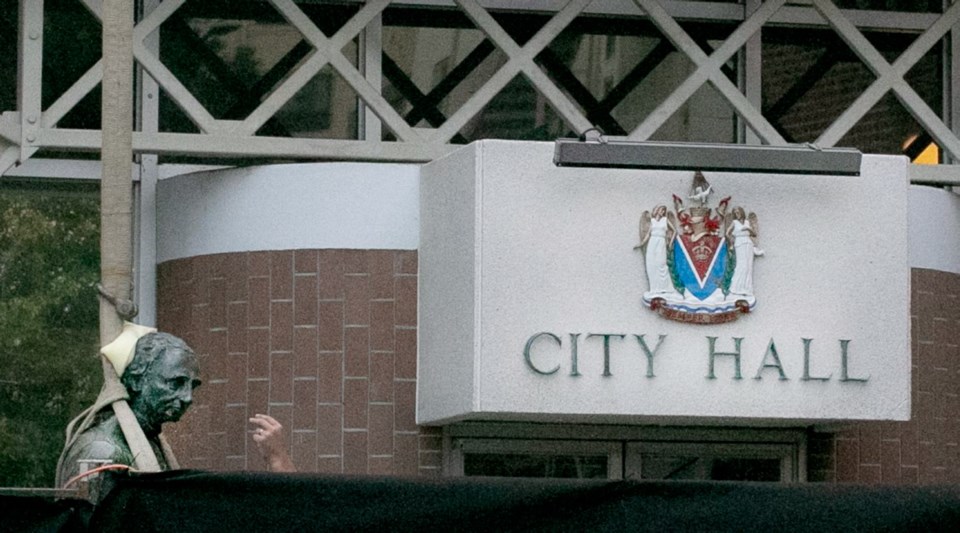City councillors and Indigenous people who discussed the swift removal of a statue of Sir John A. Macdonald from outside Victoria’s city hall knew there would be an outcry but in the end decided to “just do it.”
The removal of the statue of Canada’s first prime minister, a key figure in the introduction of residential schools, was presented to Victoria council last Thursday for a vote with tentative plans already underway to remove it on Saturday.
“We expected there would be opposition, uproar,” said Janice Simcoe, director at the Centre for Indigenous Education and Community Connections at Camosun College.
“I think it was the only process that could have taken place without all this coming to a screeching halt,” Simcoe said. “I don’t have any regrets.”
Simcoe is one of seven members of a panel called the “city family,” appointed last year that includes Victoria Mayor Lisa Helps, councillors Marianne Alto and Charlayne Thornton-Joe, Brianna Dick representing the Songhees Nation, Esquimalt hereditary chief Ed Thomas, and Indigenous community member Carey Newman.
When asked to join, Indigenous members were told and expected that the mandate was to take action on matters of reconciliation — not just talk, Simcoe said.
The first action put forward was to support First Nations in being able to walk into city hall without being confronted by Macdonald, a painful reminder of the man who oversaw the introduction of the residential school system.
“We knew that no matter whether it was introduced as an idea or whether it was set up as an educational space, as so many people have said should have been done, or whether it was just done, that the response to that challenge would be big and it would be huge,” Simcoe said.
“And so in the end the decision was made to just do it and we’ll deal with the outcry, and the response of the mayor, and councillors, was ‘you have spoken and I’m listening as I committed I would.’ ”
The city family made the decision and it was put before city council to be endorsed or rejected, and it was adopted 8-1.
“I was a member of this city family and the decision was to do this quickly,” Helps said. “What now is possible is to have a conversation as a community about, was it the right balance between commemoration and reconciliation?”
The events leading up to the statue removal included a briefing note to councillors Monday night, a buried council agenda item on Tuesday, the decision to remove the statue announced on the mayor’s website Wednesday — the same day her re-election campaign office opened — and a vote by council on Thursday, which was International Day of the World’s Indigenous Peoples.
Helps said nothing was orchestrated and it was all a “coincidence.” She said she can’t speak to “conspiracy theories on backroom dealings.”
Coun. Pam Madoff said she asked during a five-minute break last Thursday if the decision could be delayed but she was told the crane to haul away the 635-kilogram bronze statue had already been booked.
Helps said she told Madoff the crane was “probably” booked but that it was still a council decision.
City staff follow the direction of council, staff don’t follow the direction of the city family panel, Helps said.
Both the crane and wording for a sign explaining the statue removal were only “confirmed” on Friday, after the 8-1 vote to remove the statue, Helps said.
Madoff said she was torn between wanting to support the reconciliation process and at the same time wanting to uphold her promise to the electorate for full disclosure. “It was a no-win situation” and she voted for an outcome that was already decided, she said.
Madoff calls the process a mess and said she’s had a week of sleepless nights including the question: “Why couldn’t we wait? What was the big timing issue?”
In hindsight, Madoff, who wants the statue relocated, said she wishes she had tried to delay the vote until council resumes meeting in September.
Simcoe said the process of taking an action that challenges privilege is always deeply controversial — “and we know that the action that was taken here challenged privilege.”
Her opinion is that whatever was done, the process would have been questioned.
“If we waited until Sept. 6, we should have waited until October, if we waited until October we should have waited until after the elections, we should have had a referendum, we should have, we should have,” Simcoe said.
“But no matter what happened, this conversation would have been going on.”
The statue’s relocation harms no one, she said.
Simcoe commends the mayor and councillors for their “extraordinary courage.”
In hindsight, Helps said she wishes she had sent a briefing note to councillors on Aug. 3, a week before the vote.
“My big takeaway is there needs to be a more cohesive and clear working relationship between the city family and city council,” Helps said.
Council was supportive of the city family decision but wanted to be more involved and Helps said she has heard that message.



